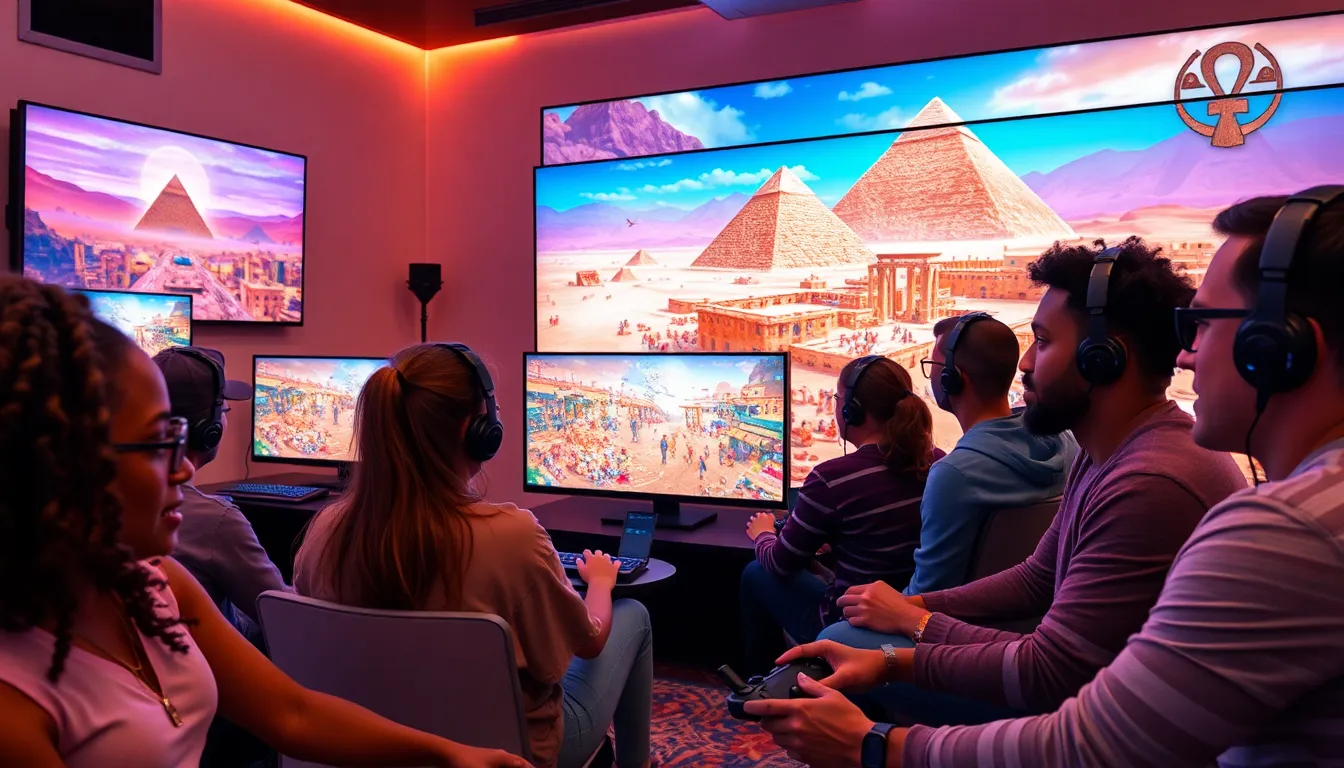Table of Contents
ToggleImagine stepping into a vast desert, an oasis appearing just when you think you’ll be parched forever. Welcome to the world of Ancient Egypt in video games, where players don their virtual sandals and navigate pyramids, pharaohs, and mysteries galore. These games let us explore one of history’s most fascinating civilizations without a single grain of sand in our shoes, all while giving us storytelling and adventure that can be both hilarious and breathtaking. In this text, we take a deep jump into how video games depict this ancient realm, blending rich narratives with mythological references. So, grab your controllers and let’s wander through the digital sands of time.
Exploring Ancient Egypt in Video Games

Ancient Egypt has always held a cherished spot in the cultural imagination, so it’s hardly surprising that gamers find themselves captivated by its charm. Video games transport them to the land of the Nile, where vast cities and monumental structures sing stories of old.
From action-packed adventures to slow-paced exploration games, developers have paid homage to this ancient civilization by crafting digital landscapes that evoke both awe and curiosity. Players can wander through bustling marketplaces, engage with ancient hieroglyphs, and escape the clutches of mummified terrors, all from the comfort of their gaming chairs. The appeal lies not just in the eye-catching graphics, but in the ability to engage interactively with a world steeped in history.
Key Themes in Ancient Egyptian Gaming
Immersive Storytelling and World-Building
World-building is the cornerstone of any great video game, and Ancient Egypt provides an alluring backdrop for epic tales. Here, players aren’t just moving through levels: they become part of a densely layered narrative. Developers intricately weave myth and legend into the gameplay, crafting stories that feel alive. They might encounter gods intervening in human affairs, or navigate political intrigues that echo real historical events.
Mythology and Deities in Gameplay
The pantheon of Egyptian gods serves as a stunning foundation for enriching gameplay mechanics. From the wise Osiris to the fierce Sekhmet, these figures often guide or challenge players, adding another layer of engagement. Imagine trying to appease Ra through in-game actions while battling creatures created by Set. The rich mythology transforms not only how players experience the game but also adds depth to their understanding of Egyptian lore.
Cultural Representation and Accuracy
In an era where representation matters, the portrayal of Ancient Egypt in video games seems a double-edged sword. On one hand, many titles strive for cultural accuracy, diligently researching historical elements, art styles, and social structures. But on the other hand, inaccuracies occasionally creep in, leading to a mismatch between playability and authenticity.
Games must balance enjoyment with respect for the real-world civilization. Players appreciate when developers take cultural representation seriously, as this can enrich the experience significantly. By involving historians or cultural experts during development, they embrace Ancient Egypt’s complexity and nuance, helping players develop a deeper appreciation for its contributions to human history.
Popular Games Set in Ancient Egypt
Assassin’s Creed Origins
Possibly one of the most famous titles set in Ancient Egypt is “Assassin’s Creed Origins.” Here, players explore an open-world rendition of Ptolemaic Egypt, replete with its breathtaking landscapes and densely populated cities. The game also explores themes of democracy and governance while incorporating crucial elements of mythology that enhance player engagement. Climbing the pyramids is not merely a task: it’s an experience that feels impactful and grand.
Pharaoh: A New Era
On a different note, “Pharaoh: A New Era” takes a more strategic approach. This city-building game bursts with vibrant art and resource management as players construct the magnificent cities of the Nile Valley. The historical accuracy in functionality illustrates the everyday life of Egyptians, allowing players to grasp both the architectural and cultural intricacies of this great civilization.
The Importance of Art and Architecture
When it comes to Ancient Egypt, one cannot overlook the spellbinding art and architecture that defined an era. Video games have the unique ability to showcase these elements authentically, allowing players to marvel at stunning recreations of temples, tombs, and hieroglyphics.
The aesthetic choices made by game designers often reflect the grandeur of the original monuments. Developers painstakingly recreate art that serves a narrative purpose, giving life to the stories behind the artworks and structures. This engagement encourages players to appreciate and reflect on artistic traditions rooted in thousands of years of history.
Player Experience and Historical Engagement
Video games centered on Ancient Egypt do more than offer entertainment: they create avenues for players to engage with history actively. Immersive environments encourage exploration and critical thinking, enabling individual learning experiences that can be more memorable than traditional forms of education.
Players become explorers, historians, and sometimes even archaeologists. This transformative experience captures the essence of what makes gaming special. By interacting in a world where history unfolds, they gain insight into the culture’s nuances and challenges.




